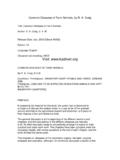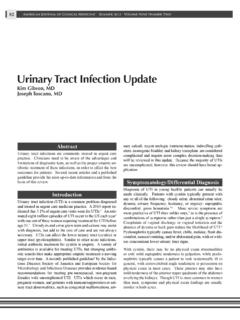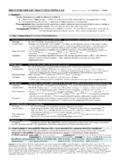Transcription of Diseases of the urinary system - Assiut University
1 Diseases of the urinary system Anatomy and physiology: The composition of blood is kept constant mainly through the selective elimination of water and solutes by the kidneys rather than by these materials in food. This control involves balancing the body's input of ions and water with the amounts excreted. As Na+ and Cl- are the most abundant somatically active solutes in plasma, control of plasma volume and tonicity can be largely achieved by controlling the amounts of these ions and water excreted. Functions of the kidney: 1- Excretory: Excretion of water products and drugs in the urine. 2- Regulatory: The kidney regulates the volume, osmotic pressure and reaction of the blood. 3-Endocrine: The kidney produces the following hormones. a) Rennin- angiotensin system : It is produced by the juxtaglomerular apparatus which is made of specialized cells on the smooth muscle cells located on the afferent glomerular arteriole as it enters the glomerulus.
2 These cells secrete rennin which converts angiotensinogen in the blood to angiotensin I. Angiotensin II is generated from angiotensin I by angiotensin converting enzyme. Angiotensin II is both a vasoconstrictor and the most important stimulus for release of aldosterone. b) Erythropoietin: is a glycoprotein produced mainly by the kidney and is one of the major stimuli of erythropoiesis. c) Prostaglandin: The kidney produces prostaglandin E2, a powerful vasodilator agent. 4-Metabolic: a) Vitamin D metabolism: Naturally occurring vitamin D requires hydroxylation in the liver and again by the kidney to produce dihydroxychole-calciferol. Loss of this metabolic activity in diseased kidney results in renal osteodystrophy. b) Protein and polypeptide hormones: The kidney is the major site for catabolism of insulin, parathyroid hormone and calcitonin.
3 In renal failure, the metabolic clearance of these hormones is reduced. Gross structure of the kidney: The basic unit of kidney function is the nephron of which there are about 1,000,000 nephrons in each kidney. Urine formed in the tubular part of the nephron collects in the renal pelvis and then flows through the ureter to the bladder for subsequent elimination via the urethra (Figs 1 and 2). Fig. 1: Diagrammatic represent the normal anatomical arrangement of urinary system The glomerulus (about 200 m in diameter) is formed by invagination of a tuft of 50 anatomizing capillaries into the dilated blind end of the nephron (Bowman's capsule). The capillaries are supplied by an afferent arteriole & drained by a slightly smaller efferent arteriole. The glomerular membrane separates blood from the glomerular filtrate in Bowman's capsule, that is composed of three layers: - 1- Endothelial layer of the capillary.
4 2- Basement membrane. 3- Layer of epithelial cells. Fig. 2: Diagrammatic represent the normal histological structure of the nephron. The permeability of the glomerular membrane is 100-500 times that of the usual capillary. The endothelial cells lining the glomerulus have thousands of small holes (fenestrae). Outside the endothelial cells is a basement membrane, composed of a meshwork proteoglycan fibrillae, which has also large spaces through which fluid can filter. A layer of epithelial cells lines the outer surface of the glomerulus. These cells consist mainly of finger like projections that cover the basement membrane. These fingers form slits called slit-pores through which the glomerular filtrate filters. Functionally the glomerular membrane permits the passage of substances up to 4 nm in diameter & does not allow the passage of those with diameter greater than 8 nm.
5 The proximal convoluted tubules (PCT) is made of a single layer of cells which show on their luminal edges brush border due to the presence of numerous microvilli. The structure of the loop of Henle differs according to its location in the kidney. Cortical nephrons have short loops of Henle with a thin descending limb & a thick ascending limb. The cells lining the thick segment of the loop of Henle form a larger lumen & lack of prominent brush borders. In contrast, juxtamedullary nephrons have somewhat longer loops of Henle and thin segments on both sides of the loop. The distal convoluted tubule (DCT) has a similar structure to the thick segment of the loop of Henle. DCT from large number of different nephrons drain into a common collecting duct & then via a papillary duct into the renal pelvis. The largest collecting ducts empty through the renal pelvis through the tips of the renal papillae, which protrude into the renal calyces.
6 A kidney has about 250 large collecting ducts, each of which transmits the urine from 4000 nephrons. The epithelial lining of the collecting duct is composed of a layer of cuboidal cells, which gradually become taller as the collecting tubule merges into capillary duct. Nephrons are arranged into 10-15 groups called maligning pyramids. The nephrons are all oriented so that the Bowman's capsules with related proximal & distal tubules are situated in the outer layers of the kidney cortex while the loops of Henle & Malpighian pyramids form the medullary rays. Fig 3: Diagrammatic representation of the blood supply to cortical and justamedullary Nephrons. Diseases of the urinary system Principles of renal insufficiency: disease of the kidneys, and in some instances of the ureters, bladder and urethra, reduce the efficiency of the kidney's functions, disturbances in protein, acid- base solute and water homeostasis and in excretion of the metabolic end-products will result.
7 It is noteworthy to mention that, Diseases of the bladder and urethra are more common and more important in farm animals than the Diseases of the kidneys; but some studies on renal insufficiency is necessary because many disease condition such as pyelonephritis, embolic nephritis, amyloidosis and nephrosis, all may eventually lead to renal insufficiency or renal failure. Renal insufficiency: It is defined as a degree or relative loss of renal function, but the animal can survive its state. Meanwhile, renal failure is defined as complete loss of renal tissue function and the animal can't survive or can't continue its existence. Renal efficiency depends on the functional integrity of the individual nephrons. Renal insufficiency can occur because of: * Extrarenal causes - abnormalities in the rate of blood flow to the renal tissues.
8 * Intrinsic factors from the kidneys such as: a) Abnormalities of the glomerular filtration rate. b) Abnormalities of tubular reabsorption . The first one (extrarenal) is depending upon the vasomotor and in animals is affected only by emergencies such as in hemorrhage, shock and dehydration which may lead to renal ischemia causing tubular necrosis with eventual development of renal insufficiency. Glomerular filtration and tubular reabsorption can be affected independently of other such as in hemoglobinuric nephrosis, the glomeruler filtration is unaffected while the tubular reabsorption is depressed. However, because of the common blood supply to the glomerulus and tubule, damage to any part of the nephron is usually followed by damage of the remaining part. The development of renal dysfunction is depends on the degree of loss of renal function.
9 If the degree of loss, and there fore the degree of dysfunction is such that the animal is not able to continue its existence, it is said to be a state of renal failure and the clinical syndrome of uremia is manifested. Pathophysiology of the renal insufficiency: Damage to the glomerular epithelium destroys its selective permeability and permits the passage of plasma proteins mainly albumin into the capsular fluid. Complete cessation of the glomerular filtration may occur when there is an extensive damage to the glomeruli, particularly if there is acute swelling of the kidneys, but in many instances the anuria of the terminal stages of acute renal disease is caused by back diffusion of all glomerular filtrate through the damaged tubular epithelium. When the renal damage is less severe, the compensatory mechanism on the part of residual nephrons is to maintain the total glomerular filtration by increasing the glomerular filtration rate.
10 Decreased glomerular filtration is also reflected by retention of the blood urea and other nitrogenous end products of metabolism. Although blood level of urea is not significant in the production of clinical signs, they are used as a measure of glomerular filtration rate. When the glomerular filtration is reduced, phosphate and sulphate retention also occurs and may precipitate to renal metabolic acidosis. Phosphate retention may cause secondary hypocalcaemia due to increased calcium excretion in the urine. Variations of the potassium levels in serum also occur and usually depend on potassium intake. Hyperkalemia is a serious complication and may lead to myocardial asthenia and fatal heart failure. Hyponatremia eventually occurs in all cases of renal failure and clinical dehydration may occur due to loss of large quantities of fluids caused by solute diuresis.






